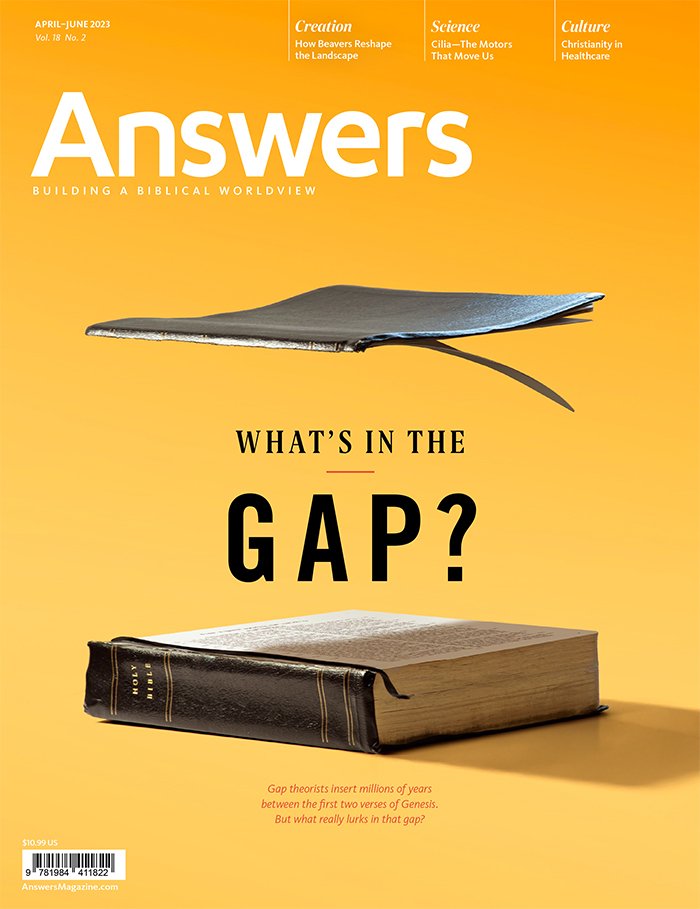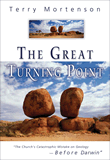What’s in the Gap?
Gap theorists insert millions of years between the first two verses of Genesis. But what really lurks in that gap?
Couldn’t the billions of years be from before Adam?” The sweet older lady I was speaking with at church had been a Christian for over 50 years. And though she would not have described herself as a scientist or theologian, when I tried to explain the biblical timeline, she tried to find room for millions of years.
Often when encountering two conflicting views, our first instinct is to find middle ground. We are called to live in unity with our brothers and sisters in Christ, yet that unity is to be based upon the solid foundation of biblical truth. Sometimes, however, Christians gravitate toward a seeming compromise that allows them to believe the Bible and what they perceive as the scientific view of origins. The gap theory is often offered as an idea that would build a bridge between the historical record of Scripture and the evolutionary timeframe of billions of years by inserting millions of years in the creation account.
At first glance, it might not seem significant to add a gap allowing for a secular timescale. But when we look at what is in the gap, it becomes clear why we must avoid this compromising view. The gap theory not only adds to Scripture, it also contradicts what God says elsewhere in his Word. It even destroys the scarlet thread of the gospel that runs throughout the Bible’s interwoven narrative.
Defining the Gap Theory
Christians who want to maintain some level of belief in the Bible’s history while adding millions of years to the creation account have to insert those years somewhere.
The gap theory tucks them between Genesis 1:1 (“In the beginning, God created the heavens and the earth”) and Genesis 1:2 (“The earth was without form and void, and darkness was over the face of the deep. And the Spirit of God was hovering over the face of the waters.”).
While a minority of scholars held long-age interpretations before the gap theory, long ages weren’t perceived as necessary to explain Genesis until about 200 years ago, when a group of geologists began arguing that the way the earth looks now can be entirely explained by processes that we see happening today, an idea called uniformitarianism. However, without considering the earth-changing catastrophe of the global flood (Genesis 6–8), these geologists appealed to slow and gradual processes that would take millions of years to shape the planet—hence the need for millions of years of history.1
Uniformitarian geologists, such as James Hutton in the late 1700s and Charles Lyell in the 1800s, began to study the earth’s different landforms and argued that geological evidence pointed to an earth much older than a plain reading of Scripture would allow. Lyell was not a dispassionate scientist following the evidence wherever it led—he had an agenda. He wanted to “free the science of geology from Moses.”2 However, because this branch of geology deals with history—how the earth was shaped in the past—we need a historical document that can tell us what happened. The Bible is the only infallibly true historical record that can explain what we see in the geological record. It is impossible to “free” historical science from the only eyewitness account we have.
In response to uniformitarianism, Scottish minister Thomas Chalmers was the first to popularize the gap theory in 1814. His motivation was to defend Scripture against uniformitarianism by fitting long ages into Scripture.
The gap theory exists solely to allow its adherents to believe in the secular timeline of history while interpreting the Bible literally from Genesis 1:2 onward. Proponents often reject evolution, believe the current world was created in six days, and accept a historical Adam. Nevertheless, capitulating to nineteenth century science gradually gave people the idea that the Bible was not the authoritative source for earth’s history.
The Language of Genesis 1:1–3
For Christians, Scripture must be our authority, meaning we must interpret the geological evidence in light of the Bible, not the other way around. After thousands of years of Jewish and Christian interpretation of Genesis, the majority of Bible scholars began trying to fit millions of years into Genesis only when evolutionism became the predominate scientific philosophy. No one would have devised the gap theory from the text of Scripture alone.
The gap theory makes no sense when we examine the grammar of Genesis 1. Gap theorists claim that Genesis 1:2, “The earth was without form and void,” should read “and the earth became without form and void.” However, the Hebrew word waw (and) in this passage can be used in various ways, telling us what the author means in a specific instance and how it should be translated into English. The use of this waw does not indicate a chronological progression, such as the next event in a series. Rather, the word describes the state of things at the beginning of God’s creation of the heavens and earth.
Further, the Hebrew words to describe the state of the world simply describe it as unformed and unfilled. In the context, this makes sense: God will go on to form and fill the earth in the six-day sequence of creative acts, culminating in the creation of man on the sixth day and God’s rest on the seventh day. Nothing about these terms would indicate that the creation at this stage had been ruined or was bad in some way; it was simply incomplete because God had not yet imposed order and filled it with life.
Lucifer’s World of Death and Suffering
The gap theory becomes even more problematic when we look at what’s inside the gap. To explain why the earth became without form and void, gap theorists normally place the fall of Satan and the other angels who rebelled with him (Isaiah 14; Ezekiel 28) between Genesis 1:1 and 1:2. They appeal to Isaiah 14:12: “How you are fallen from heaven, O Day Star, son of Dawn! How you are cut down to the ground, you who laid the nations low!” “Day Star” is a reference to Satan. The following verses describe Lucifer’s prideful rebellion and how he was cast to Sheol.
The gap theory becomes even more problematic when we look at what’s inside the gap.
Gap theorists also point to Ezekiel 28:13–19, which describes Lucifer’s dwelling in Eden. But the garden’s description includes details not given in the Genesis description of Eden, such as “stones of fire” and calling it the “mountain of God.” Gap theorists put these together and say that Satan originally lived on earth in a different Eden but then rebelled and fell. Because the Bible doesn’t explicitly say when Satan fell, gap theorists conveniently place this event in the gap, claiming that the earth became without form and void in the aftermath of Satan’s fall. However, the “stones of fire” and “mountain of God” are likely descriptions of a heavenly setting different from Eden. When Satan appeared in the garden of Eden in Genesis 3, he was clearly already a fallen creature, though still splendid (as described in Ezekiel), which is probably why he easily persuaded Eve.
Poetic and prophetic passages like Ezekiel are not always strictly chronological—Satan’s appearance in Eden may have been placed before the description of his pre-fall existence to emphasize that he is the same tempter from Eden. The passage is called a “lamentation over the king of Tyre” (Ezekiel 28:12), and the point is, just as Satan fell when he became prideful and tried to usurp God’s position, so the King of Tyre, no matter how powerful, would fall for the same reason.
To explain how the earth became without form and void, gap theorists invented a catastrophe they call Lucifer’s flood, which they claim happened around the time of Satan’s fall and resulted in the majority of the fossil record (which biblical creationists would attribute to the global flood of Noah’s day). Around 6,000 years ago, in six days, God then created today’s world from the ruins of the destroyed world.
However, this concept of Lucifer’s flood does not work from a biblical point of view. The Bible presents Satan as a spiritual being, like other angels, whose proper home is in the spiritual realm. God created the earth to be the perfect home for human beings because we are both physical and spiritual and need a physical home, unlike beings who are solely spiritual.
Messing with the Narrative
Genesis 1:31 states, “And God saw everything that he had made, and behold, it was very good.” In the gap theory, “everything” includes a whole destroyed earth marked by death, disease, carnivory, thorns, Satan, and the rest of the fallen angels. But the Bible teaches that human and animal death, thorns, disease, and suffering are results of Adam’s sin, his fall—which in the gap theory happens millions of years after the fossil record that attests death, disease, and thorns.
God’s inspired Scripture provides the unified narrative of his interaction with humanity, a narrative that Answers in Genesis often summarizes with the 7 C’s: Creation, Corruption, Catastrophe, Confusion, Christ, Cross, and Consummation. This narrative details God’s relationship with the people he made in his image. Man’s idea, the gap theory, proposes an entire history of billions of years before Adam was ever created, meaning that the Bible’s narrative would not even explicitly address the vast majority of earth’s history.
Compromise Doesn’t Work
The gap theory also has problems from the secular perspective. The secular view of world history does not allow for a huge discontinuity, as would be the case if the ancient geological record were the result of the earth’s destruction. Evolutionists believe that all life on earth, including creatures preserved in the fossil record, is descended from the last universal common ancestor that lived billions of years ago. That timeline leaves no room for a mass destruction and a re-creation.
Though gap theorists try to align their timeline with the secular view of long ages, those long ages do not support the portions of the scriptural account that gap theorists agree with, such as the creation of Adam and the flood of Noah’s day. For example, secular archaeology routinely dates ancient sites as older than the biblical record would allow. The oldest of these sites, located in Kenya, is dated by evolutionists to 3.3 million years old and contains stone tools, hence evidence of human activity. But any evidence of human activity would have to be dated after the flood just 4,500 years ago. Similarly, the secular conventional dating of more well-known sites of Skara Brae in Scotland, the ancient city of Jericho, and the Sphinx in Egypt also contradict the biblical timeline because all of them are dated well before the global flood.
Also, while the gap theory allows for millions of years and attempts to explain the fossil record, it does not generally allow for evolution. Rather, it entails a literal six-day creation after the gap, lumping the gap theory in with the biblical view of creation that evolutionists reject.3
Compromise Isn’t Necessary
The Bible doesn’t allow for a gap in Genesis—and we don’t need one.
Nineteenth-century theologians wrongly believed it was necessary to adapt our reading of Scripture to accommodate naturalistic and uniformitarian interpretations of scientific data. Though gap theorists try to fill the supposed gap between Genesis 1:1 and 1:2 with compromise, the gap theory doesn’t agree with Hebrew grammar, it doesn’t fit the Bible’s narrative arc, it contradicts the plain reading of Scripture, and it fails at what it sets out to do—to provide a “respectable” way for Christians to believe in millions of years and the Bible. The result is a divide between theology and science, setting up the false dichotomy that, though the Bible speaks about spiritual issues, we must turn to science to know about the real world. Sadly, many people who begin with compromise end up rejecting the Bible and Christianity entirely.
The Bible doesn’t allow for a gap in Genesis—and we don’t need one. The Bible’s clear history of creation in six days, the introduction of death and suffering into creation after Adam’s fall, and the global flood in Noah’s day explain the evidence we find in the geological record. Our strongest position for answering evolution and millions of years is standing firm on a biblical foundation.
Answers Magazine
April–June 2023
Gap theorists insert millions of years between the first two verses of Genesis. But what really lurks in that gap?
Browse Issue SubscribeFootnotes
- Much of the scientific progress made since then is a problem for uniformitarianism and evolution. For instance, the events surrounding the eruption of Mount St. Helens show that rapid geological change can happen in hours and mimic landforms that supposedly formed over millions of years.
- Charles Lyell, quoted in Katherine Lyell, Life, Letters and Journals of Sir Charles Lyell, Bart., vol. 1 (London: John Murray, 1881), p. 268.
- As in Tom McIver, “Formless and Void: Gap Theory Creationism” Creation/Evolution Journal vol 8, no 3, Fall 1998, https://ncse.ngo/formless-and-void-gap-theory-creationism.
Recommended Resources

Answers in Genesis is an apologetics ministry, dedicated to helping Christians defend their faith and proclaim the good news of Jesus Christ.
- Customer Service 800.778.3390
- © 2024 Answers in Genesis







